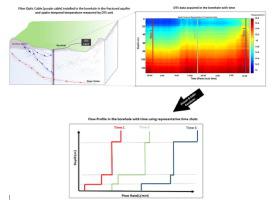Journal of Hydrology ( IF 5.9 ) Pub Date : 2021-05-12 , DOI: 10.1016/j.jhydrol.2021.126450 Behzad Pouladi , Olivier Bour , Laurent Longuevergne , Jérôme de La Bernardie , Nataline Simon

|
Fractured aquifers are known to be very heterogeneous with complex flow path geometries. Their characterization and monitoring remain challenging despite the importance to better understand their behavior at all spatial and temporal scales. Heat and correspondingly temperature data have gained much interest in recent years and are often used as a tracer for characterizing groundwater flows. In the current work, a fast computer code is developed using Ramey and Hassan and Kabir analytical solutions which converts the temperature profile to the flow rate profile along the borehole. The method developed is validated through numerical simulations. A global sensitivity study recognizes the media thermal properties as the most influential parameters. For testing the method in the field, fiber-optic distributed temperature sensing (FO-DTS) data were used to monitor the dynamic behavior of fractured aquifers at the borehole scale at the Ploemeur-Guidel field site in Brittany, France. DTS data are used to infer the flow rates in the different sections of a fractured wellbore (flow profile) and calculate the contribution of each fracture to the total flow. DTS data were acquired for about three days in three different hydraulic conditions corresponding to two different ambient flow conditions and one pumping condition. Flow profiling using distributed temperature data matches satisfactorily with results from heat-pulse flow metering performed in parallel for cross-checking. Moreover, flow profiling reveals the daily variations of ambient flow in this fractured borehole. Furthermore, it shows that during ambient flowing conditions, shallow and deep fractures contribute roughly equally to the total flow while during the pumping condition, the deepest fractures contribute more to the total flow, suggesting a possible reorganization of flow and hydraulic heads depending on the hydraulic conditions. Thus, although the proposed method (DTS data and proposed framework) may be costlier and is based on indirect characterization through temperature measurements, it provides real-time monitoring of complex fracture interactions and recharge processes in fractured media. Thus, this method allows for a full analysis of the temporal behavior of the system with a simple and fast analytical model. Furthermore, thanks to its narrow width, DTS can be used and installed in boreholes for long-term monitoring while heat-pulse flow metering may lead to head losses in the borehole and may not be always possible depending on some borehole conditions. One of the limitations the approach proposed is the proper knowledge of the thermal properties of media required to infer the flow rate from the temperature. Nevertheless, surface rate measurement can be useful to constrain these properties and reduce the flow profiling uncertainty. Thus, the method proposed appears to be an interesting and complementary method for characterizing borehole flows and groundwater dynamics in fractured media such as for instance, monitoring the recharge dynamic.
中文翻译:

利用分布式温度感测数据对钻孔流进行建模,以监测压裂介质中的地下水动力学
已知破裂的含水层在复杂的流道几何形状中非常不均一。尽管重要的是要更好地了解其在所有时空尺度上的行为,但它们的表征和监测仍然具有挑战性。近年来,热量和相应的温度数据引起了人们的极大兴趣,并经常用作表征地下水流量的示踪剂。在当前工作中,使用Ramey和Hassan和Kabir分析解决方案开发了快速的计算机代码,该代码将温度曲线转换为沿井眼的流速曲线。通过数值模拟验证了所开发的方法。一项全球敏感性研究认为,介质的热特性是最有影响力的参数。为了在现场测试方法,光纤分布式温度感测(FO-DTS)数据用于在法国布列塔尼Ploemeur-Guidel油田现场监测裂隙含水层在井眼尺度上的动态行为。DTS数据用于推断裂缝井眼不同部分的流速(流量曲线),并计算每个裂缝对总流量的贡献。在与两种不同的环境流量条件和一种泵送条件相对应的三种不同的水力条件下,采集了约三天的DTS数据。使用分布式温度数据进行的流量分析与并行执行以进行交叉检查的热脉冲流量计的结果令人满意地匹配。此外,流量剖析揭示了该裂缝性井眼中环境流量的每日变化。此外,它表明在环境流动条件下,浅层和深层裂缝对总流量的贡献大致相等,而在泵送条件下,最深层的裂缝对总流量的贡献更大,这表明根据液压条件,流量和液压头可能会发生重组。因此,尽管所提出的方法(DTS数据和所提出的框架)可能更昂贵,并且基于通过温度测量的间接表征,但它提供了对复杂裂缝相互作用和裂缝介质中补给过程的实时监控。因此,该方法允许使用简单而快速的分析模型对系统的时间行为进行全面分析。此外,由于其宽度较窄,可以使用DTS并将其安装在钻孔中以进行长期监控,而热脉冲流量计可能会导致钻孔中的压头损失,并且根据某些钻孔条件,可能并非总是可能。所提出的方法的局限性之一是对从温度推断流量所需的介质热特性的正确认识。尽管如此,表面速率测量对于限制这些特性并减少流量分布的不确定性还是有用的。因此,提出的方法似乎是一种有趣且互补的方法,用于表征裂隙介质中的井眼流量和地下水动力学,例如监测补给动力学。所提出的方法的局限性之一是对从温度推断流量所需的介质热特性的正确认识。尽管如此,表面速率测量对于限制这些特性并减少流量分布的不确定性还是有用的。因此,提出的方法似乎是一种有趣且互补的方法,用于表征裂隙介质中的井眼流量和地下水动力学,例如监测补给动力学。所提出的方法的局限性之一是对从温度推断流量所需的介质热特性的正确认识。尽管如此,表面速率测量对于限制这些特性并减少流量分布的不确定性还是有用的。因此,提出的方法似乎是一种有趣且互补的方法,用于表征裂隙介质中的井眼流量和地下水动力学,例如监测补给动力学。











































 京公网安备 11010802027423号
京公网安备 11010802027423号